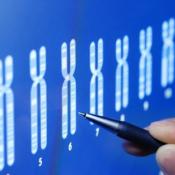In Embryos, Crispr Can Cut Out Whole Chromosomes—That's Bad
By Megan Molteni,
Wired
| 10. 29. 2020
The DNA-cutting tool has been hailed as a way to fix genetic glitches. But a new study suggests it can remove more than scientists bargained for.
IN 2017, RESEARCHERS at Oregon Health and Science University came out with some big (if true) news. Led by a reproductive biologist named Shoukhrat Mitalipov, the scientists had used the Nobel Prize–winning molecular tool known as Crispr to fix a heart-condition-causing mutation in human embryos—a first in the US. A week later, the journal Nature published details of these boundary-pushing experiments. Up until that point, viable embryos had only been Crispr’d once before, in China. As WIRED reported at the time, Mitalipov’s team’s editing appeared to work surprisingly well. But one thing didn’t go as expected.
Crispr works by cleaving DNA apart at a specific location in the genome. Then it’s the cell’s job to repair the resulting double-stranded break. One way to make sure it does it right is to supply a bit of corrective DNA along with the Crispr components. But Mitalipov’s group reported that their embryos didn’t use the template they provided. The embryos had been created by fusing a healthy donor’s egg with a sperm that carried the mutation. But it turned...
Related Articles
By Aisha Down, The Guardian | 11.10.2025
It has been an excellent year for neurotech, if you ignore the people funding it. In August, a tiny brain implant successfully decoded the inner speech of paralysis patients. In October, an eye implant restored sight to patients who had...
By Jessica Hamzelou, MIT Technology Review | 11.07.2025
This week, we heard that Tom Brady had his dog cloned. The former quarterback revealed that his Junie is actually a clone of Lua, a pit bull mix that died in 2023.
Brady’s announcement follows those of celebrities like Paris...
By Heidi Ledford, Nature | 10.31.2025
Late last year, dozens of researchers spanning thousands of miles banded together in a race to save one baby boy’s life. The result was a world first: a cutting-edge gene-editing therapy fashioned for a single person, and produced in...
By Lauran Neergaard, AP News | 11.03.2025
WASHINGTON (AP) — The first clinical trial is getting underway to see if transplanting pig kidneys into people might really save lives.
United Therapeutics, a producer of gene-edited pig kidneys, announced Monday that the study’s initial transplant was performed successfully...




